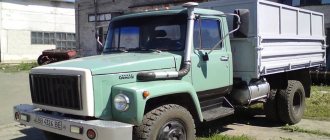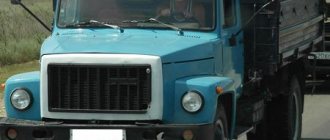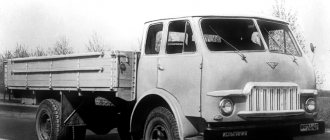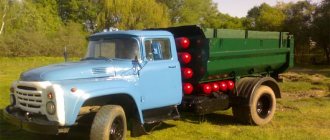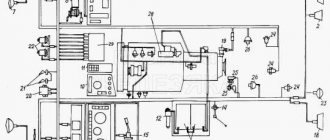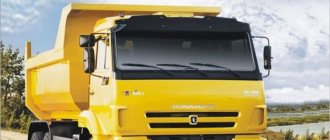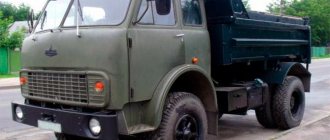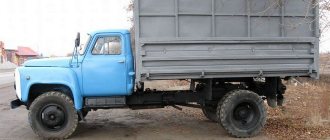Machine modifications
During the production of the Gas-3309 car, the market saw many modifications. The main models include:
- 33090 - a truck with a base chassis and an MMZ D 245.7 engine, corresponding to Euro 2 and equipped with a turbine;
- 3309 “Dobrynya” - a car with a longer body, reaching 7.9 meters, has a cabin with a berth, spoilers and aerodynamic elements;
- 33091 - another extended version of the truck by 1.4 meters, also equipped with the MMZ D 245.7 power unit;
- SAZ 35071 is a dump truck with 3-way loading/loading, manufactured on the basis of Gaz-3309, transports loads up to 4.13 tons and has a body volume of 4.5 cubic meters. meters;
- 33092 - a truck with a double cab that allows you to transport up to seven people at a time, is equipped with MMZ D 245.7, has many add-ons for special equipment: workshops, firefighting vehicles, etc.;
- SAZ 35071 is another dump truck with 3-way loading/unloading, transports cargo up to 4.13 tons, and has a body volume of up to 5 cubic meters. meters, and when installing extension sides - up to 10 cubic meters. m;
- 33094 - a longer version of the Gaz-3309 truck, used as a bus;
- 33096 - a truck with a flatbed superstructure, equipped with a Cummins ISF 3.L engine, used for transporting special-purpose cargo;
- 33098 is another onboard Gaz-3309 vehicle, but with a YaMZ 53442-10 turbocharged diesel unit.
The main modifications of the Gas-3309 are presented above, but in practice there were significantly more of them. This is due to the high demand for the car, so the specialists of the Gorky plant tried to cover the needs of representatives of different areas and constantly worked on optimizing the technical part.
Peculiarities
Despite its rather short history, the GAZ-4301 truck has quite a lot of different reviews, most of which are positive. As the owners note, this truck is a simple, durable, unpretentious and load-lifting vehicle that can cope with many different tasks.
Fuel consumption
The model has a soft and very effective suspension. As practice has shown, the truck engine has an average diesel fuel consumption when driving in urban conditions from 19 to 22 liters per 100 kilometers. On the highway, fuel consumption rarely exceeds 17 liters per 100 kilometers.
Reasons for popularity
The designers of the GAZ-4301 created many improvements and major modifications, which made it possible to produce a very popular car on the cargo transportation market.
Additional amenities include: simple engine starting using an electric torch, a driver's seat with a shock absorption system, effective ventilation and heating systems.
Standardization and unification of most units and elements helped achieve lower production costs.
The Gorky Automobile Plant created a high-quality model of the GAZ-4301, which allowed the production sector to move forward productively.
But due to the fact that the quality of the engine was not at a very high level, and its performance was unsatisfactory, demand on the market was low, which became a serious obstacle to mass production of the model.
One of the factors that has a negative impact on the demand for the car is the low cross-country ability of the truck.
Thanks to the installation of a heavier and more powerful engine, the load on the front wheels also increased: this often led to the GAZ-4301 often getting stuck on soft surfaces.
Another factor that influenced the discontinuation of the GAZ-4301 was the economic crisis of the 90s, as a result of which agricultural enterprises lost state support and funding.
As a result, due to weak truck sales and low demand, product prices were significantly increased.
Ultimately, this led to the discontinuation of turbodiesel production, and in 1995 the GAZ-4301 was discontinued. The total number of trucks that rolled off the assembly line is 28,158.
You can take a closer look at the design of the GAZ-4301 in the following video:
What did the Gorky automakers “stuff” their truck with?
GAZ 4301 has a six-cylinder 125-horsepower diesel engine of the GAZ-542 brand with an air-cooling system and a power of 125 hp, which is a licensed analogue of a Deutz diesel engine (a permit was acquired for a whole range of six- and four-cylinder engines of various capacities). The GAZ 4301 engine is the first and only personally manufactured diesel engine at the GAZ automobile plant. It has proven itself to be quite agile, unpretentious, traction and rational. The duration of uniform movement of the machine is, as a rule, short relative to the total duration of its operation. When moving in urban conditions, equipment moves uniformly only 15...30% of the time, 40...45% with acceleration and 30...40% with deceleration.
The fuel system, designed to supply the GAZ-542 with diesel fuel, its storage and purification, includes two types of pumping equipment: a low-compression piston fuel injector and a high-compression, mechanical, adjustable, 2-mode, in-line centrifugal injector. The fuel pump is a plunger type, with the ability to pump fuel manually. Engine 542 has the following fuel filters: coarse filter - filter separator with network component; fine cleaning - a replaceable filter component is made of paper. Air filtration belongs to the dry category, has replaceable filters and a debris level sensor. Air cooling is carried out through a gear fan transmission using a fluid coupling.
The transmission is represented by a 1-disc closed dry friction clutch, with a spring diaphragm and hydraulics. GAZ 4301 gearbox is mechanical, 5-speed, 3-way, synchronized in all gears except first and reverse. The cardan transmission is carried out by a pair of open shafts with a support in between and three hinges on bearings.
GAZ-4301 is equipped with a modern 2-circuit brake system (service, spare and parking). Brake units are mounted in each wheel; there are 2 autonomous drives for working with them. To carry out the process of braking equipment with maximum efficiency without reducing controllability and stability, a rational correspondence between the braking force and the energy incident on each wheel is required. With optimal matching of these forces, simultaneous blocking of all wheels is ensured under any road conditions. In this regard, the correspondence of the braking loads of all wheels is determined in such a way as to prevent premature blocking of the front wheels, leading to deterioration in controllability, or blocking of the rear wheels, causing the vehicle to skid, when applying maximum braking.
When the GAZ 4301 stops smoothly with a deceleration of 0.60 m/s, a redistribution occurs, due to which about 60% of the mass falls on the front axle, and the remaining 40% falls on the rear axle. Therefore, the productivity of the front wheels should be increased by 1.5 times. In this regard, the GAZ 4301 dump truck is equipped with 2-circuit brakes with two pneumatic boosters, with separate axle brakes, and a hydraulic drive. Also, the truck of this model has a 2-wire pneumatic unit that controls the trailer brake mechanism.
The brake drums of each wheel are solid, cast iron. The front drums are centered and mounted on the edges of the hubs, the rear ones - on the edges of the axle shafts. To facilitate control, they are made removable. In addition, the GAZ 4301 brake system is equipped with a device for automatically adjusting the gap in the shoe-drum system. The role of parking brakes is assigned to the brake units of the rear wheels, equipped with a mechanical drive.
The GAZ 4301 cars are equipped with original spare parts that make it possible to increase the consumer characteristics of the equipment - an electric torch mechanism for easy starting of the diesel engine, the cabin is equipped with a sprung driver's seat with a position adjustment function, there is a rational heating and ventilation system, a mechanism for blowing and washing the partially panoramic front window.
Time left until the opening of the Oldtimer Gallery
The first diesel truck of the Gorky Automobile Plant - GAZ-4301 - rolled off the assembly line 30 years ago, on April 21, 1984.
This story, as expected, had its own backstory. On August 26, 1970, by order No. 256 of the Minister of Automotive Industry of the USSR, the “Type of trucks, car trailers and semi-trailers for 1971 - 1980” was approved. In 1975, Magirus-Deutz heavy trucks with a spacious cabin and a highly efficient air-cooled diesel engine began to arrive in our country. And finally, in 1982, at the May plenum of the CPSU Central Committee, the “Food Program” was adopted, which essentially recognized the unprofitability and low profitability of collective and state farms. At first glance unrelated, these events nevertheless created the preconditions for the emergence of a new medium-duty truck from the Gorky Automobile Plant. Traditionally, GAZ products were sent to rural areas because they had a lower axle load compared to ZIL trucks. In the 1970s, the country took a course towards dieselization of the truck fleet. The Magirus-Deutz truck engine and its spacious cabin had a significant influence on the Gorky people's plan. The technical design of the GAZ-4301 was reviewed at the scientific and technical council of the Ministry of Automotive Industry on February 9, 1978. Work on the vehicle was headed by the chief designer of GAZ trucks, a highly experienced, “Lipgart-type” engineer, Alexander Mikhailovich Butusov. Valery Dmitrievich Zapoinov was appointed the lead designer for the car, and Stanislav Vitalievich Volkov was assigned to develop the design.
By Decree of the Council of Ministers of the USSR dated December 6, 1979 No. 1080 “On the prospects for the development of the Gorky Automobile Plant,” the main purpose of the truck was determined to be used in agriculture to work as part of road trains - regular flatbed and dump truck. The carrying capacity of the GAZ-4301 was supposed to be 4.5 tons, the trailer, respectively, the same. The development of the road train, which received the GAZ-6008 index, was carried out in parallel. If the load capacity of the basic road train with the GAZ-4301 truck as a tractor was 9 tons, and the total weight was 15050 kg, then the 6008 dump truck train has the weight of the body and the lifting and tipping device of the tractor (GAZ-SAZ-4509 dump truck) and the GKB-SAZ- trailer. 8536 ate a whole ton.
The new Gorky truck was supposed to use an in-line 6-cylinder air-cooled diesel engine with a working volume of 6.23 liters, developing a power of 125 hp. at 2800 rpm and maximum torque 37 kgf.m at 1600 - 1800 rpm. The USSR acquired a license for the production of the motor from the West German company Klöckner-Humboldt-Deutz after comprehensive tests. Considering that our country did not know how to make engines, all resources were mobilized to create a modern diesel engine - from GAZ, Vladimir Tractor, Yaroslavl Motor, NAMI, UralAZ. Analogs of motors from Daimler-Benz, Klöckner-Humboldt-Deutz, Perkins, Saviem, Tatra, Volvo were analyzed. In 1978-1979, a group of GAZ and NAMI specialists went on a six-day foreign business trip to the Klöckner-Humboldt-Deutz company and a ten-day trip to the Tatra national enterprise. Opinions about what the future engine should be like are divided. Some people insisted that it was possible to get by with four cylinders by increasing their diameter. A larger displacement per cylinder provides better efficiency, and rightly so. But jet oil cooling of the pistons is not necessary; it is complicated and expensive. And finally, why not use cast iron instead of steel for crankshafts - ZMZ engines have cast iron, and that’s okay! The chief designer of diesel engines, Nikolai Davydovich Parkhomenko, fought back as best he could: in the future, the loads will increase, since we will install turbocharging. At the Gorky Automobile Plant it was planned to develop a family of 4-, 5- and 6-cylinder “air ventilators” with a cylinder diameter of 105 mm and a piston stroke of 120 mm for GAZ trucks, buses of the Kurgan and Pavlovsk plants. The six-cylinder diesel GAZ-542.10 became the base model. Between 1977 and 1980, four series of 6-cylinder diesel engines were developed for extensive testing. It was expected that the service life before major repairs on roads of the second category would be 200 thousand km, and the life of the first category would be 300 thousand km.
The new truck was to replace the “breadwinner” of the plant, the GAZ-53A. From him, only the steering rod joints and the frame remained unchanged in the new product. But now low-alloy steels were also used in it (for spars 22G2TYu, for cross members - 12GS). Most of the components transferred from the GAZ-53A were revised taking into account increased loads and reduced material consumption. For example, the gear-cutting equipment of the American company Gleason installed at the factory did not allow changing the number of teeth of the driven hypoid gear of the rear axle, however, by increasing the module of the final drive gears and strengthening the rear axle housing with heat treatment, it became possible to transmit increased torque and withstand an axial load increased by 12%. The use of plastics in the GAZ-4301 compared to the GAZ-53A increased from 8.3 to 51 kg (more than six times), the use of low-alloy steels - from 54.7 to 412 kg (i.e. 7.5 times) , and the share of aluminum parts increased by 2.4 times, i.e. amounted to 155.5 kg.
At the same time, the GAZ-4301 used a time-tested steering “worm-roller” from. GAZ-51A. In addition, the design included components from the ZIL-130, KamAZ, GAZ-66 and even the passenger car GAZ-14 “Chaika” (power steering cylinder). The first three prototypes (including a dump truck) were built in 1979. The second series of samples, after making clarifications and comments, was manufactured in the second quarter of 1981. A separate story is about the gearbox. Taking into account the predominantly agricultural purpose of the road train, a special gearbox with an increased first gear ratio (10.004 versus 7.48) was developed for it, based on the four-speed GAZ-53A gearbox, which ensures confident movement at speeds of 2-3 km/h. This is important for working in tandem with agricultural implements. Tests were carried out in the field together with the Gorky Agricultural Institute. The road train worked properly with silage and grain harvesters. True, it turned out that switching to second gear is not always possible due to a loss of speed. It was necessary to reduce the gap between the gear ratios of first and second gear. The engine power reserve made it possible to do this. To ensure normal acceleration characteristics for the samples of the second series of GAZ-4301, a new - now five-speed - gearbox with a more harmonious geometric series was designed. The gear ratio of the first gear was reduced to 9.886, the second was increased from 4.44 to 5.836, and the third was increased from 2.555 to 3.224. In all gears, the gears were in constant mesh. An additional gear and a hatch in the crankcase were provided for power take-off for additional mechanisms.
Description of the GAZ-3309 (3309) model
Engine
Model - 5441 Type - Diesel, four-stroke (air-cooled), turbocharged Number of cylinders - 4 Cylinder operating order - 1-3-4-2 Direction of crankshaft rotation - Right Cylinder diameter and piston stroke, mm - 105x120 Displacement, l — 4.15 Compression ratio — 16 Rated engine power at 2600 rpm, kW (hp) — 85 (116) Maximum torque at 1600-1800 rpm N m (kgf m) — 38, 2 (39) Maximum idle speed, no more than, rpm - 2800 Ventilation system - Open High pressure fuel pump (HPF) - In-line, with a mechanical two-mode centrifugal regulator and boost corrector Low pressure fuel pump - Piston type Fuel lift pump — Plunger type for manual pumping of fuel Injectors — Closed type, injection start pressure of at least 20.08 MPa (215 kgf/cm 2 )
Important Selecting oil and gasoline for preparing the fuel mixture for the trimmer: dilution ratio table
Fuel filters
Coarse cleaning - Settler filter with a mesh filter element for fine cleaning - With replaceable paper filter elements Air filter - Dry type, with a replaceable filter element and a maximum clogging indicator Cooling system - Air with a gear-driven fan through an adjustable fluid coupling Starting aid - Electric torch device ( EFU) Starting heater - Air diesel Pressurization system - Gas turbine, with one turbocharger - with a radial centripetal turbine, with a centrifugal compressor modification S-13 and an air-to-air charge air cooler of a plate type made of aluminum alloy
Transmission
Clutch - Single disc, dry friction, permanently closed, with a diaphragm spring. Clutch drive - hydraulic Gearbox - Mechanical, five-speed, three-way, with synchronizers in 2nd, 3rd, 4th and 5th gears Gear ratios: I - 6.286; II - 3.391; III - 2.133; IV - 1.351; V - 1.0; z.x. — 5.429 Cardan transmission — Two open-type shafts with an intermediate support, three cardan joints on needle bearings Main axle transmission — Bevel, hypoid type. Gear ratio 5.5 Differential - Gear
Chassis
Wheels - Disc, with rim 6.0B-20 (152B-50V) with a split bead ring Tires - Pneumatic, radial, size 8.25R20 (240R508) models U2 (K-B4) or K-55A Imbalance of the wheel assembly with tire no more , g cm — 2500 Air pressure in radial tires: front wheels, kPa (kgf/cm 2 ) — 390 (4.0) rear wheels, kPa (kgf/cm 2 ) — 620 (6.3)
Installation of the front wheels: Wheel camber angle - 1° Lateral inclination angle of the king pin - 8° Angle of inclination of the lower end of the kingpin forward - 2°30′ Wheel toe - 0–3 mm
Springs: Four - longitudinal, semi-elliptical. The rear suspension consists of main and additional springs. Shock absorbers - Hydraulic, telescopic, double-acting. Installed on the front axle of the car
Steering
Steering mechanism type - Ball screw nut Gear ratio - 22.46 Steering rods - Tubular, non-adjustable hinges
Brakes
Service brake system - Dual-circuit with hydraulic drive and hydraulic vacuum booster in each circuit Brake mechanisms - shoe, drum type Spare brake system - Each circuit of the service brake system in case of failure of another circuit Parking brake - With a mechanical cable drive to the rear wheel brakes
Electrical equipment
Wiring system - Single-wire, negative connected to the body Rated voltage in the network, V - 24 Generator - 5101.3701 Battery - Two 6ST-110AZ or four 6ST-55AZ Starter - 3002.3708 Headlights - Two FG122-VV1E Rear lights - Two, 35.3716,351.3716 Rear fog lamp - 2412.3716 Instrument and starter switch - 2101.3704-10 or 1902.3704, with anti-theft device Windshield wiper - 711.5205 Windshield washer - 1212.5208-09
Cabin and platform
Cabin - Metal, double, two-door Cabin heater - Oil, with two radiators included in the engine lubrication system Independent heater - Air, dual-mode, runs on diesel fuel Seats - Separate: driver and passenger Tail - Metal, with an alligator-type hood and a folding grille cladding Platform - Metal Folding sides - rear and both sides
Cabin GAZ-4301
The car has a two-door and two-seater all-metal cabin, equipped with places for fastening seat belts. The cabin heater is equipped with two radiators included in the engine lubrication system. Independent heater - air, dual-mode, running on diesel fuel.
The driver and passenger have separate seats, in contrast to the common “sofa” that the GAZ-52 and GAZ-53 were equipped with. The driver's seat is equipped with a suspension that consists of a coil spring and a hydraulic shock absorber.
To ensure a comfortable fit for drivers of any size. Changing the longitudinal position of the seat is ensured by a slide that has eight fixed positions. The total travel of the slide is 136 mm.
The seat cushion has three fixed positions, which provide a level of inclination of 4, 7 and 10 degrees to the horizontal. Changing the angle of inclination of the seat back is provided by a hinge mechanism, which infinitely changes the degree of inclination of this backrest. The passenger seat in the GAZ-4301 cabin is folding to facilitate easy access to the independent heater.
Nutrition
The fuel system, which supplies the engine with diesel fuel, is presented in the form of two pumps. One of them is a low-compression piston injector, and the second is a high-compression, mechanical, adjustable one. It works in two modes.
The fuel pump is a plunger system that makes it possible to pump diesel fuel into the rune. The engine uses several filters to clean fuel: for coarse filtering and for fine filtering.
As the first filter, the engineers decided to use a separator with a special mesh. For fine cleaning purposes, a replaceable paper element is used. Air filtration is dry. Replaceable filters are used here, as well as a sensor that shows the level of clogging. Cooling is carried out using air.
Technical characteristics of GAZ-3309
The high demand for Gas-3309 is due not only to a large selection of modifications, but also to its excellent technical characteristics. The main parameters include:
| Specifications | Values |
| Load capacity with / without awning, t | 4,5 / 4,35 |
| Total weight, t | 8,18 |
| Dimensions (LxWxH), m | 6.436x2.7x2.905 |
| Wheelbase, m | 3,77 |
| Front/rear track, m | 1,63 / 1,69 |
| Ground clearance, cm | 26,5 |
| Turning radius, m | 8 |
| Maximum speed with full load, km/h | 95 |
| Fuel consumption, l / 100 km/h | 14,5 |
| Climbing angle, degrees | 25 |
| Loading height, m | 1,365 |
Engine MMZD-245
During its production, the Gas-3309 was supplied with many engine options, but the most widespread was the MMZ D-245.7. This is a 4-stroke diesel engine equipped with turbocharging and a liquid cooling system. The power unit had four cylinders with a vertical arrangement and a diameter of 11 cm. The piston stroke during operation was 12.5 cm.
With a 4.75-liter displacement, the engine produces 119 horsepower at 2400 rpm. The highest torque at crankshaft speeds from 1300 to 1600 rpm is 413 N*m.
The engine operates with a YAZDA or Bosch injection pump, as well as a plunger fuel priming pump. Additional features include the presence of Bosch nozzles, fine/coarse filters, and a dry paper filter with a replaceable element. The lubrication system is combined and operates under pressure. The radiator is built into the power unit, and the oil filter does not require disassembly.
To achieve the desired cleaning parameter, an exhaust recirculation system is used, controlled from a special unit. There is a closed crankcase ventilation. Turbocharging operates on the gas turbine principle.
In addition to the MMZD-245, the Gaz-3309 truck was also equipped with a Yaroslavl engine of 4.43 liters and 134.5 horsepower. The consumption of this engine is lower and amounts to 15.5 liters per “hundred”.
Trucks with 3.76-liter Cummins diesel power units of the ISF 3.8L type with a capacity of 152.3 horsepower were produced in small quantities. In even rarer cases, the Gas 562.10 engine was installed, which is a copy of the engine from Austria SteyrM16.
Important Spacious all-wheel drive Canadian Argo all-terrain vehicles are designed for harsh climates
Transmission
All engines of the Gas-3309 diesel dump truck were paired with a 5-speed manual transmission with synchronized gears. Its features include constantly meshing gears and working with a dry single-plate clutch mechanism.
As for the cardan part, there is a pair of open shafts with an intermediate support, as well as a trio of cardan joints. The Gas-3309 differential is made in the shape of a cone and is gear-based, and the axle shafts are completely unloaded.
Chassis
All variants of the Gas-3309 are available with rear-wheel drive, and a durable frame and dependent front/rear suspension on leaf springs are used as the main base. At the front, they work together with 2-way telescopic shock absorbers. There are two types of springs at the rear: main and additional.
Thrust rubber pads are installed in the front brackets at the front, which absorb the main forces and prevent the movement of the springs. Longitudinal displacements in places of deflection occur thanks to springs, and the edges of the spring elements rest on rubber supports. The shock absorbers in the front axle have a dismountable design, which simplifies their maintenance.
The truck is equipped with disc wheels with a 6.0B-20 rim and 8.25 R20 radial/pneumatic tires with a pressure of 4.0 in the front and 6.3 kgf/cm2 in the rear.
The camber/toe parameters are 1 degree and from 0 to 3 mm, respectively. If repairs are necessary, as well as replacement of failed components, the Gas-3309 suspension is partially or completely disassembled. In this case, strong impacts on the springs are excluded due to the risk of damage.
Brake system
- Working - hydraulic vacuum booster and hydraulic drive.
- Spare - any of the serviceable circuits is used.
- Parking - mechanical system with rear wheel locking.
A drum system with shoes is used as a braking mechanism, providing the necessary braking efficiency.
Technical characteristics of GAZ 3307
Before studying the characteristic features of the main components of such a truck, it is advisable to analyze in detail the technical characteristics, load capacity of the GAZ 3307 and other parameters that are important during operation. The following indicators deserve mention:
- dimensions (LxWxH) - 6.33x2.33x2.35 m;
- load capacity - 4.5t;
- rated engine power 92 kW;
- maximum speed - 90 km/h;
- tank volume - 105 l.
It is important to consider that the curb weight of the Gas 3307 is 3.2 tons, and at maximum load, the weight of the Gas 3307 will increase to 7.85 tons. The vehicle is characterized by a relatively low speed and low load capacity, but due to its features, it is the optimal solution for transporting small loads off-road
Transmission
Having found out how much gas 3307 weighs, it is advisable to study the car’s transmission in more detail. The gearbox used directly depends on the power unit, which is provided by the modification. Gasoline variations were equipped with a 4-speed manual transmission. Its characteristic feature is the noise that occurs during movement.
The GAZ 3307 TTX diesel engine is also equipped with a manual transmission, which has 5 speeds. In this case, a special dry clutch equipped with a hydraulic drive is used to shift.
Suspension
The truck has a dependent suspension, the design of which includes special type of springs with shock absorbers on the front wheels. The rear wheels are equipped with standard springs, the ends of which are mounted in special rubberized support pads.
The car belongs to the rear-wheel drive category and is driven by twin wheels. As the model improved, its suspension was updated, which allowed the car to move more confidently on poor quality road surfaces.
Steering
The steering system in the GAZ 3307 is extremely simple and does not include hydraulic boosters, which are typical for most trucks. The basis of this unit is a worm-type mechanism, through which the driver controls the direction of movement of the car.
Brake system
One of the most reliable components of the design of such a truck is the brake system. It is characterized by increased efficiency, which is confirmed by the car’s braking distance of 36.7 m when driving at a speed of 60 km/h. Such a system implies the presence of two circuits, which allows you to stop the machine even if one of them fails.
The circuits are equipped with vacuum-type amplifiers, which promotes effective braking using drum mechanisms.
Car engine
Advantages and disadvantages
Such a car has quite a lot of advantages that made it popular at the time of release and disadvantages due to which it eventually ceased to be in demand. First of all, the vehicle has good cross-country ability, which allows it to be used in rural areas and on bad roads. In addition, the truck has other advantages:
- excellent ground clearance;
- abundance of spare parts, which facilitates repair work;
- reliability of the braking system;
- affordable cost of new and used models;
- modest dimensions and ease of operation;
- spacious cabin and availability of various modifications.
However, there are a number of disadvantages that do not allow this car to be considered the optimal solution for most buyers. First of all, this is a low payload and high fuel consumption, which makes operating the truck for commercial purposes unprofitable. The lack of a hydraulic system in the steering greatly complicates the use of the car.
It is also worth noting the modest technical equipment of the cabin, the noise of the gearbox when driving, as well as the modest power of the power units, which is not always enough for comfortable travel. The outdated design, which is fully consistent with the trends at the time of the model’s initial release to the market, is not an advantage.
Chassis
The GAZ-4301 has a dependent suspension at the front, which has two longitudinal semi-elliptic springs. There is also an additional rubber compression buffer that prevents the springs from sagging.
The rear suspension is implemented according to a similar design. It also has longitudinal semi-elliptical springs and additional metal springs that act as shock absorbers. Speaking of shock absorbers: the front suspension is equipped with hydraulic, telescopic, bi-directional shock absorbers.
Specialists increased the energy intensity of the spring suspension and limited their deflection under the weight of the load by installing rubber compression buffers, which are located on the side member of the frame structure near the front axle.
The lower flange of the side members at the rear of the frame structure has almost the same buffers that limit the degree of deflection of the springs.
History of the creation and development of the fourth generation of GAZ cars (4x2)[edit]
In the early 80s, when developing the design of the GAZ-3307 truck and other fourth-generation models, broad unification of components and assemblies of existing production vehicles was envisaged (the chassis and carburetor power plant, in fact, were transferred from the GAZ-53-12 model), which made it possible reduce the cost of cars and at the same time facilitate their maintenance, repair and operation. The car received a more spacious modern double cabin, equipped with an effective ventilation and heating system, first used on the experimental GAZ-4301 truck in 1984. The steering design, unlike its predecessors, includes power steering for the first time. Serial production of a 4.5-ton GAZ-3307 (4x2) truck with a ZMZ-511 carburetor engine with a power of 125 hp. started at the end of 1990.
In 1992, GAZ launched serial production of the 5-ton GAZ-4301 truck with a 6-cylinder air-cooled diesel engine GAZ-542 with a power of 125 hp, produced under license from the German company Deutz, as well as the GAZ-SAZ-4509 agricultural dump truck at its chassis for operation as part of an 8.6-ton GAZ-6008 dump truck (GAZ-4509 dump truck + GKB-8536 trailer). Despite significant design differences, for example, the wheels of models 3307 and 4301 are not interchangeable, but the cars are almost identical in appearance. Production of the GAZ-4301 continued until 1995. A total of 28,158 trucks of the GAZ-4301 family were produced.
In 1993, production of a replacement for the GAZ-52 model was launched - a 3-ton truck GAZ-3306 with a 4-cylinder air-cooled diesel engine GAZ-544 with a power of 85 hp. According to some reports, in 1992, a 2.5-ton modification 33061 with a carburetor engine from the GAZ-52 was produced in a limited edition. Production of the three-ton GAZ-3306 (mainly in the “Cargo Taxi” version) continued until 1995.
Important TOP 3 popular models of Chelyabinets cranes and their technical characteristics
At the end of 1994, with the development at GAZ of the production of a four-cylinder air-cooled turbodiesel GAZ-5441 with a power of 115 hp. The GAZ-3309 model with a lifting capacity of 4.5 tons appeared, completely unified in the chassis and cabin with the GAZ-3307 (externally it differs only in the engine air intake pipe on the left side of the cabin). By mid-1996, it completely replaced the carburetor truck 3307 from the assembly line. In mid-1997, GAZ’s own production of diesel “air vents” was considered economically unfeasible, as a result of which the production of the 3309 model was suspended until the end of 2001, and the carburetor 4 was restored to production. 5-ton GAZ-3307. Subsequently, GAZ reoriented itself to the purchase of Belarusian diesel engines MMZ D-245.7 (a similar water-cooled turbodiesel is installed on the ZIL-5301 “Bychok”) from the Minsk Motor Plant (MMZ), which began to be installed on the model 3309, which was resumed in production.
Since 1999, as part of the 4th family of GAZ trucks, the all-wheel drive (4x4) vehicle GAZ-3308 “Sadko” has been mass-produced in military (carrying capacity 2 tons) and civilian (2.3 tons) versions.
Since 2006, the GAZ-3307, GAZ-3309 and GAZ-3308 have been equipped with gasoline and diesel engines certified to Euro-2 environmental standards, and since 2008 - Euro-3. Large-scale production of models 3307 and 3308 with ZMZ gasoline engines was actually discontinued in 2009, but for some time their limited production continued for special versions certified for government agencies (for example, in 2010, 406 units of GAZ-3307 were produced). The carburetor model 3307 also continues to be exported, for example, to Belarus, where it is equipped with gas equipment. In 2010-2012 medium-tonnage GAZ trucks (4x2) were equipped primarily with the MMZ D-245.7 E-3 diesel engine (model 3309), and all-wheel drive (4x4) models 33081 “Sadko” and 33086 “Zemlyak” were equipped with the MMZ D-245.7 E-2 diesel engine. Since 2013, all 4th generation GAZ trucks for civilian use have received the MMZ D-245.7 E-4 turbodiesel with a power of 119 hp as the base engine.
Since 2012, a modification of the GAZ-33096 with a Cummins ISF 3.8L diesel engine, similar to that used on the GAZ-3310 Valdai truck, has been produced to order. Since 2013, the engine has been certified for Euro 4.
In February 2013, a modification of the GAZ-33098 with a new Russian-made diesel engine, the YaMZ-5342.10 Euro-4 class, went into production, as well as a new version of the GAZ-33088 “Sadko” all-terrain truck with a similar YaMZ-5344 engine of the EEC-96 class.
A van on a GAZ-33091 chassis with a long wheelbase.
Long-wheelbase "Dobrynya" with tuning cabin trim and sleeping compartment.
About the history of the model
The development of the GAZ-4301 truck model started at the Gorky Automobile Plant back in the early 80s. In 1982-1983, a pilot batch of these machines underwent serious testing. Since such trucks were intended mainly for agriculture, the first tests were carried out on collective farms near Moscow. Then a test motor rally of nine thousand kilometers was organized - from Gorky to Kuibyshev, then to Aralsk, Tashkent, with the finish line in the Pamir Mountains.
The tests were successful, but the diesel GAZ-4301 reached mass production only in 1992. In a country with a planned economy and absolute dominance of the state in all spheres of the economy, there was no urgent need to switch to diesel cars, although it was recognized that it needed to be ensured. Gasoline was still cheap, and car factories were consistently supplied with orders for gasoline trucks.
In parallel with the production of the GAZ-4301 on the assembly line, the production of a dump truck “agricultural truck” on its chassis was organized - under the GAZ-SAZ-4509 brand. This agricultural grain dump truck was intended to work as part of the 8.6-ton GAZ-6008 dump truck train (together with the GKB-8536 trailer). In general, the prospects for the GAZ-4301 truck in Soviet-style agriculture would be good. However, after the collapse of the USSR, there was no agriculture in the country, at least in its previous form. It was completely destroyed.
A note from 1984 about the prototype of the GAZ-4301 diesel dump truck “agricultural truck”, exhibited at VDNKh.
Since the very concept of a truck created on the basis of the GAZ-3307 was archaic, and the economic conditions in the country had radically changed (no government subsidies, no demand for such vehicles), the new diesel truck was discontinued by 1995.
Why was the GAZ-4301 truck discontinued?
Despite the fact that the first production diesel truck of the Gorky Automobile Plant was reliable and quite high-tech, its production was curtailed in 1995. This was due to several reasons:
- Although the first diesel engine from GAZ was quite economical and powerful, there were practically no craftsmen in the country who understood diesel equipment. GAZ-4301, the engine of which could not be repaired on collective farms, was doomed to long downtime after breakdowns;
- The vehicle's insufficient cross-country ability was due to the peculiarities of its design. The diesel engine was too heavy, which put a high load on the front axle. This in turn led to the machine easily getting stuck on soft soils and in mud;
- The global crisis of the early 1990s led to a drop in demand for trucks;
- The cessation of government funding for the plant led to the fact that the plant simply could no longer produce diesel engines.
Despite the fact that the last GAZ-4301 trucks rolled off the production line in 1995, they are still in use in Russia and the CIS. The main problem when choosing this truck is the lack of spare parts.
Reviews from GAZ-4301 owners
In general, reviews from GAZ-4301 owners about these cars are positive. The truck is durable, unpretentious, and has a large load capacity. A “workhorse” that “carries anything, anywhere.” The suspension is soft and works efficiently. The actual diesel fuel consumption, according to the owners, is 19-22 liters per 100 km in the urban cycle and 16-17 liters per 100 km when driving on the highway.
The GAZ-542.10 engine is characterized by many owners as quite reliable, durable and high-torque: “For a mileage of more than 1.5 million km, there was only one engine repair and two fuel system repairs”; “Once I was driving loaded, and calmly pulled a loaded ZIL behind me. The operating temperature of the engine is up to 170 degrees, but it never heats up above 120 degrees. It takes care of its working life up to the “capital” without problems, only the rings and liners are changed. And - no problems with the cooling system, since it is air.
But not everyone is lucky. There are also reviews that these engines “do not run for a long time” and also have an extremely unpleasant “disease”: their crankshaft bursts, and so “successfully” that it makes a hole in the block. Any repair of this engine, just because it belongs to the “autoexotic” category, becomes a serious problem. Spare parts for it cannot be found during the day, and they are very expensive.
Therefore, those who “burned themselves” by buying a GAZ-4301, “buying themselves problems,” are advised to choose another, some more mass-produced truck model and avoid such a less common model. Because behind the external gloss and decent condition, there may be a twisted mileage and an already exhausted engine. Few technicians undertake repairs because they do not know the motor.
The synchronizers that are installed on the gearbox of this vehicle require very careful treatment. The gearbox itself works clearly and reliably, the speeds are switched on smoothly. The performance of the braking system also deserves positive feedback (the brakes on the GAZ-4301 are pneumohydraulic, like on the PAZik). The power steering is the same as on the GAZ-66, it is good, but in severe frosts (about -30 degrees) it may not always work. The metal from which the truck cabin is made is not of high quality - after 5-7 years it begins to rust and rot non-stop.
In general, many owners call the GAZ-4301 an “eternal car” - because “you will never sell it to anyone.” “In 1995, I bought a new GAZ-4301 for $5,000... If only prices for new equipment were like this now!”
